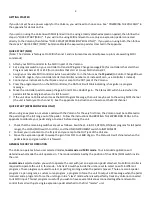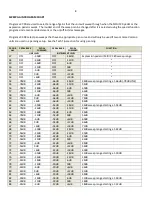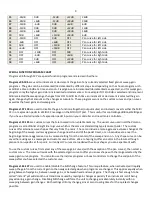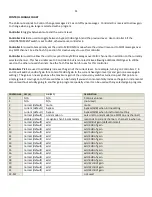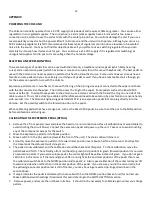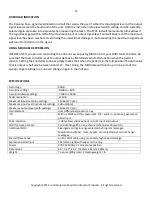
3
MIDI mode
is selected when you wish to control the unit with a MIDI controller or a computer. In this mode the unit will
accept Program Change messages (to select various programs such as fixed gains or pedal ranges), Control Change
messages in "instant access" form (to enable/disable certain functions such as bypass, mute, or boost), or Control
Change #0 as a message from a moving pedal (to sweep the gain) .
MIDI mode and the expression pedal:
In MIDI mode the unit responds to both CC #0 message and the expression pedal
to sweep the gain. This is a great convenience if you have a MIDI pedal far away from the unit and an expression pedal
close to the unit and want to use one or the other without missing a beat. If one pedal is used, and the user switches
over to the other pedal, the new pedal must move through the position of the original pedal before it takes control of
the gain to insure that there is no abrupt jump in the gain. With this feature both pedals operate as smoothly as if there
were just one pedal.
UNDERSTANDING THE SWITCH SETTINGS
Inside the Volcano is a 7 position selector switch used to set various parameters in the Volcano. The switch is accessed
by removing the 2 screws on the front panel and sliding the unit out until the switches are visible. The switch functions
are described here:
The LINE(+4dB)/INSTRUMENT(-10dB) switch
is used to change the
headroom range of the unit to accommodate either line level signals
or instrument level signals. When set to LINE the input can accept
12dB more of signal at the input before overload than it can in the
INSTRUMENT setting, but also limits the amount of available boost in
the programs to +6dB. When set to instrument the input can accept
all instrument level signals and can even accept lower line level
signals before overload and has the advantage of allowing up to
18dB of boost.
If you are planning on using the Volcano between the guitar and amp, or even in most amp effect loops, the
INSTRUMENT setting is the best because of the extra boost offered. If you are using the unit with a very hot effect loop,
or after high level line effects where the extra boost is not needed but the extra input headroom is needed, then the
LINE setting is best. Either setting works perfectly fine for an instrument such as a guitar and the choice when used this
way is determined by the maximum boost the user needs.
The MIDI/LOCAL switch
is used to set the unit to
MIDI mode
or to
LOCAL mode
as described earlier. The setting of this
switch also determines whether the 4 switches (labeled 8-4-2-1) determine the MIDI channel number (when in MIDI
mode) or the local program (when in LOCAL mode).
Switches 8-4-2-1:
When in MIDI mode these switches will set the MIDI channel number. The values 8-4-2-1 indicate the summing weight
of the switch (where 8 adds 8 to the channel number and so on). Refer to the MIDI Channel Switch Chart in the
appendix to determine the switch setting for various channels. All switches off set the unit to channel 1 and all switches
on set the unit to channel 16.
When the switch is set to LOCAL mode, then the switches determine the local program. See SETTING THE LOCAL
PROGRAM to see the programs available and what they do.
The CALIBRATE/NORMAL switch
is used only once when a new expression pedal is first matched up to the volcano in
order to take advantage of the full sweep range of the pedal and to be able to use almost any type of expression pedal
or volume pedal with the Volcano. See the appendix for detailed instructions on how to calibrate a pedal.
Summary of Contents for Volcan
Page 1: ...Volcano MIDI and Expression Pedal Controlled Volume ...
Page 16: ...15 ...



